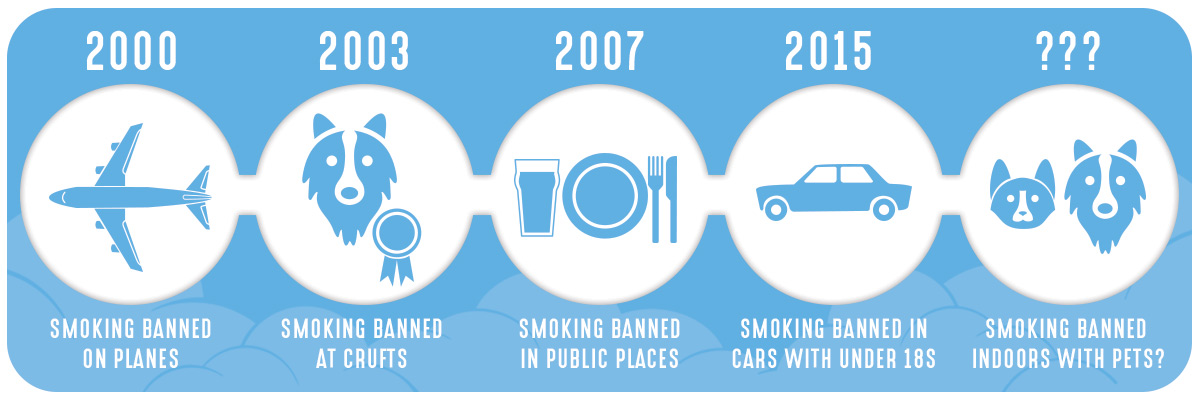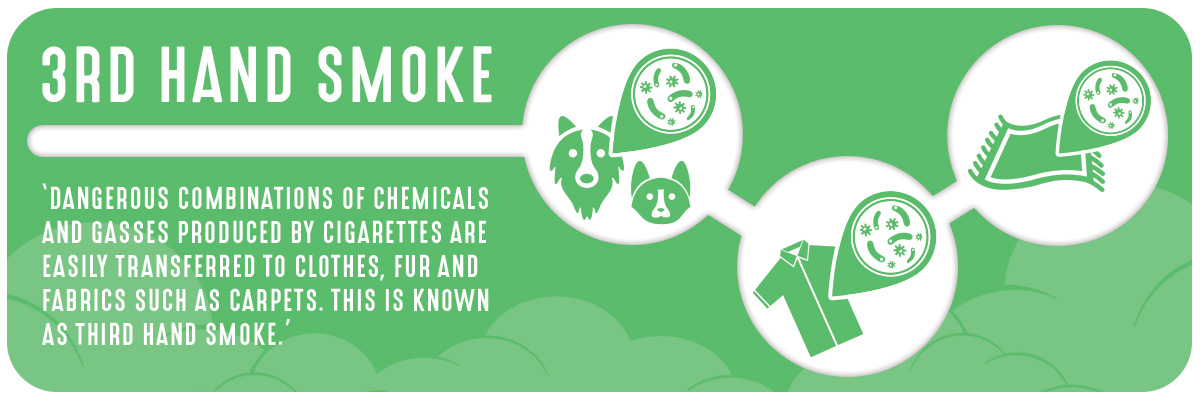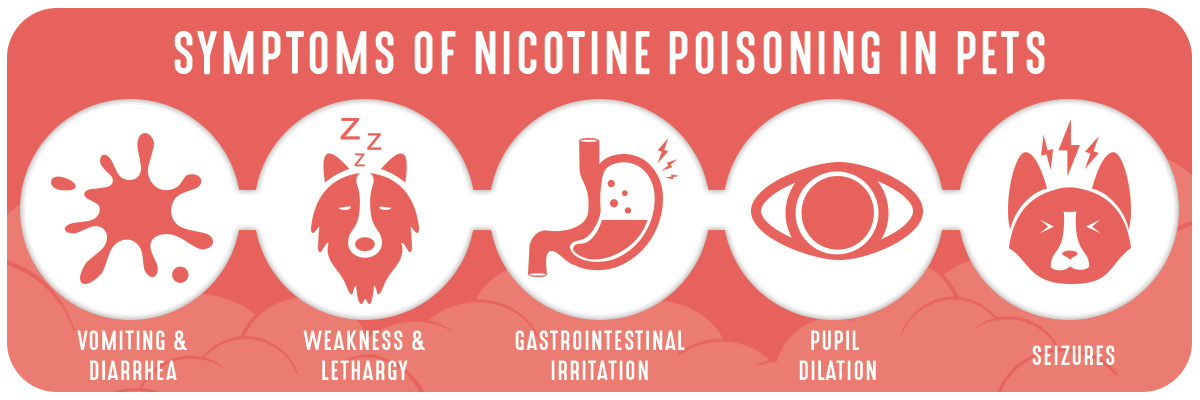Second-hand Smoking And Pets
Second-hand smoke is undeniably dangerous, when tobacco combusts it produces a cloud of smoke which contains chemicals that are linked to cancer, respiratory diseases and more. Over the years we’ve seen more and more laws passed limiting where you can smoke, the biggest impact of which was the 2007 ban on smoking in enclosed public places, such as pubs, clubs and offices. As well this, there’s the more recent ban on smoking in cars where a child under the age of eighteen is present, which you can read more on vaping and driving here, whilst the rise in popularity of vape kits could potentially provide a solution for many.
This is undeniably a move in the right direction, but could we be doing more? You see it’s not just humans that are affected by the risks relating to second-hand smoke, you could also be putting your beloved household pets at risk as well. From dogs to rabbits, cats and birds; all animals are at risk when they come into contact with second hand smoke.
This shouldn’t be news to us, we’ve understood the impact of smoking on our health since the 1970s; while the much-loved dog show, Crufts banned smoking at their event in 2003, four years before the new smoking ban came into place across the UK. Animals we keep as pets often have a similar physiology to our own, so it’s no surprise they can suffer like us.
Unfortunately, when it is the case that animals come into contact with second hand smoke, this is not covered by law. It is not yet deemed a crime for pets to live in houses where owners smoke or transported in vehicles where smoking takes place. Veterinarians and animal public health bodies have been calling for changes to be made and for owners to face up to their responsibilities, for a number of years.

Cigarettes are dangerous to animals in a number of ways, and it can affect each animal differently. It’s not just a lit cigarette that poses a threat either, tobacco is poisonous and its ingestion can be often fatal if not spotted soon enough.
Pets are at risk of second hand smoke because of their close proximity to their owners. Animals like dogs and cats will snuggle up to owners where possible. The risk is also increased with caged animals or those that live in tanks as they can not leave the room.
In 2015, Clare Knottenbelt released a statement relating to her study on the effects of smoking in homes where pets live, “Our findings show that exposure to smoke in the home is having a direct impact on pets. It risks ongoing cell damage, increasing weight gain after castration and has previously been shown to increase the risk of certain cancers.’’
Pet owners who smoke also need to consider the risk of third hand smoke. In 2009 a study published by Harvard Medical School, summarised that the dangerous combinations of chemicals and gasses produced by cigarettes are easily transferred to clothes, fur and fabrics such as carpets. This known as third-hand smoke and presents a clear danger to animals, particularly self-cleaning animals, such as cats and dogs.

HOW DOES SMOKING AFFECT YOUR PET?
The RSPCA, since their formation in 1824, have made it their mission to prevent cruelty to animals in any way possible. In 2019, they listed the risks of smoking to different pets and it’s important to know the potential harm you could be doing:
Dogs
Smoking around dogs will lead to an increased likelihood of respiratory illnesses, allergies and eye problems (it was the last point that prompted Crufts to invoke their ban). The size of a dog’s nose can also come into play, those with larger or longer noses are at greater risk of nasal cancers, dogs with shorter noses will suffer more from lung cancer.
Cats
Cats find themselves equally at risk, from both second hand and third hand smoke. They have a greater chance of developing the blood cancer known as Lymphoma, as well as respiratory conditions such as bronchitis and asthma. An example of a self-grooming animal, cats can easily ingest the toxic elements of cigarette smoke on their fur when cleaning.
Birds
Birds are smaller in size and have a remarkably advanced respiratory system which is incredibly efficient at processing oxygen, and unfortunately toxins from the atmosphere like those found in cigarette smoke. It was this last reason that canaries were used for decades in mines, to alert humans to the presence of dangerous gasses. They’re also prone to skin and eye diseases caused by smoke.
Fish
Held in stationary (often open-top) tanks, fish are especially at risk to second smoke and other smoking-related issues. Water does not act as a barrier, and the toxins in smoke easily dissolve into water - poisoning the animal inside. Because of their relative small size, even small amounts can be very harmful.
Small Rodents
Mice, hamsters and other small pets will suffer from respiratory issues when they come into contact with second-hand smoke. Emphysema and vascular disease are common complaints. There is no safe threshold of smoke that a pet can imbibe, even if a window is open the risk is still there.
WHAT TO DO IN CASE OF POISONING OF PETS?
The symptoms of nicotine poisoning in pets include vomiting, diarrhea, weakness, lethargy and seizures. Nicotine poisoning requires immediate treatment and you should seek assistance from a veterinarian immediately.

Coughing, Drooling, Breathing Difficulty
Nicotine poisoning around pets is more common than one would think and sadly is a rising trend due to the direct cause of nicotine containing products being left around unattended. E-liquids are the most obvious case of this happening, containing a liquid form of nicotine concentrate which can easily be swallowed or come into contact with when not supervised. Before e-liquids hit the market however, there were also cases of pets coming into fatal contact with cigarettes and even nicotine gum, which also includes the chemical xylitol (toxic to pets). It’s important to always keep nicotine products out of reach from pets at all times, according to the Pet Poison Helpline,
‘nicotine is a rapid acting toxin and, often, pets will show signs of poisoning within 1 hour of ingestion’.
Here are some useful signals to be made aware of which could suggest your pet has been poisoned and is in need of veterinary attention immediately.
This is often as a result of inhaling a toxic substance and results in an adverse effect which is fortunately highly visible to owners. It’s important to never directly exhale any nicotine products in the face of a pet as they are exposed directly to a substance they aren’t used to. Contact veterinary care immediately if these symptoms prove severe and cause your pet apparent discomfort.
Vomiting, Diarrhea, Disorientation, Lethargy, Convulsions, Pupil Dilation, Gastrointestinal Irritation
These symptoms are most commonly associated with swallowing of poisons and as stated often occur only an hour after ingestion. The degree to which pets are affected by nicotine depends on how much is ingested as well as how much the animal weighs. Symptoms have been experienced at doses as low as 1mg per kg, whilst the average lethal dosage in dogs is 9.2mg per kg. If your pet shows any severe signs of these symptoms, as well as staggering or heart palpitations, it is vital to get in touch with a vet as soon as possible.
Excessive Scratching, Swelling, Licking, Agitation
Obviously these are common traits of household pets yet if any of these symptoms appear extremely recurrent it is possible your pet has come into physical contact with nicotine. Always keep a lookout for red skin underneath the coat and if it becomes ulcerated or is bleeding, then please seek veterinary aid promptly.
VAPING AROUND PETS - HOW TO BE SAFE
Vaping has proven itself to be an effective way of quitting smoking ‘there are approximately 2.8 million people currently using e-cigarettes in Great Britain’ states the Office for National Statistics.
There are more and more advocates for their use, ranging from Cancer Research UK to the Royal College of Physicians, all of this bolstered by the findings of Public Health England’s 2014 landmark study, which stated amongst other findings that e-cigarettes are 95% less harmful than cigarettes.
This is fantastic news for humans, but what about animals - particularly our pets? Let’s consider Dr Jane Bellows confirmation that human lungs are ‘virtually identical’ to cat and dog lungs and the fact that vape kits feature none of the tar and carcinogens of a conventional cigarette.
The result is a device that produces no second hand or third hand smoke. If the short term and mid term studies are anything to go by, switching to a vape kit could not only help you, but also your pets and loved ones - a very compelling argument.
The common vape kit will use a liquid that contains nicotine, it is this liquid that is turned into vapour by the device. There have in the past been worries about the resulting effects of contact with this vapour, particularly in children.
After further studies by the California Department of Public Health who monitored the air quality of a particularly vapour heavy environment - a vape store, they discovered that the air quality was of a similar quality to a standard environment. Dr Michael Siegel found
This study, although conducted under very high exposure conditions in a small, non-ventilated vape shop with many employees and customers vaping and clouds of vapor visible, did not document any dangerous levels of exposure to any hazardous chemical.
TIPS ON VAPING AROUND PETS
When vaping around pets it’s important to pay attention to your pets reaction to the vapour, certain smells may cause them to act strangely, and other, particularly pungent blends can cause them displeasure. When starting out e recommend a simple flavour such as fruit or menthol.
We always encourage responsibility when it comes to the storage and use of vape kits. While e-liquid in it’s aerosolised form (vapour) is safe to inhale; in its liquid form it is toxic to humans and animals alike, because it contains nicotine. We recommend you always keep your device and e-liquid out of sight and reach of animals.
This advice came too late for one dog owner in Cornwall. In 2014, Mr Sutton’s 14 week-old bull terrier, Ivy, managed to pierce an e-liquid bottle and ingest a small amount of nicotine-containing liquid inside. Despite treatment from a vet, she unfortunately died the next morning from symptoms related to nicotine poisoning.
SUMMING UP
It is undeniable that smoking is a dangerous act, for you and those who are surrounded by it. Its link to disease and death is not just limited to humans. By switching to a vape kit, you can increase the length and quality of your pet’s life, as well as yours.
We’re always here to assist with making the switch to vaping, and our product range is accessible to users of all experience levels. For more information, visit our website www.vapeclub.co.uk or please don’t hesitate to contact us regarding any queries surrounding vaping among pets or vaping in general.
How To Guides & Useful Information


